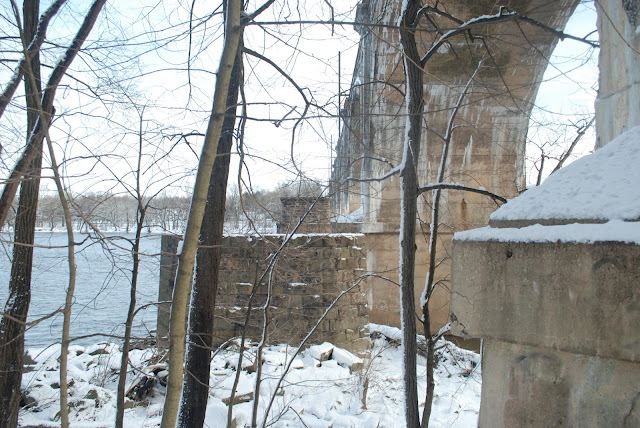It used to be the Reading Railroad Bridge, but now it is maintained by the CSX Corporation (freight trains) and is used by CSX, Amtrak, and SEPTA's West Trenton commuter line. It connects Yardley, PA, with Ewing, NJ. I pass it every day on the way to work, and it looks spectacular in early morning light. It looks attractive in twilight on the way home from work, too.
The problem is there are not any places to pull over to take a picture from the New Jersey side (Route 29) that I travel daily. There is a hiking path next to the river, but no access to it except from quite a bit north or south. I wouldn't be able to get a good shot without some hiking or biking.
The Pennsylvania side had to be explored. After the "Nemo" Nor'Easter dropped about four inches of snow on us, we traveled up Route 32, also known as the River Road, looking for a convenient pull-off from which to get a good shot. There were none, at least visible in the snow. We parked at a park,
hiked across the street, and carefully climbed down through the trees, vines, and brush to the riverbank.
 |
| Margie climbing; photo by Fred |
This method won't be possible when there's normal traffic or once the brush fills in (I don't take traffic or poison-ivy risks), but I got some good shots today.
We walked up to the bridge and stood under it as if to make its acquaintance. I am fond of this bridge because it looks like an ancient Roman viaduct to me. It is 1445.5 feet long and has fourteen (14!) arches. The first and last arches go over Route 29 in New Jersey and Route 32 in Pennsylvania.
Beside my CSX Roman Viaduct Bridge are some masonry piers I wondered about. These, as it turns out, supported the older, 1875 wrought-iron Yardley Centennial Bridge.
 |
| Piers from the Yardley Centennial Bridge |
 |
| Margie shooting; photo by Fred. |
















